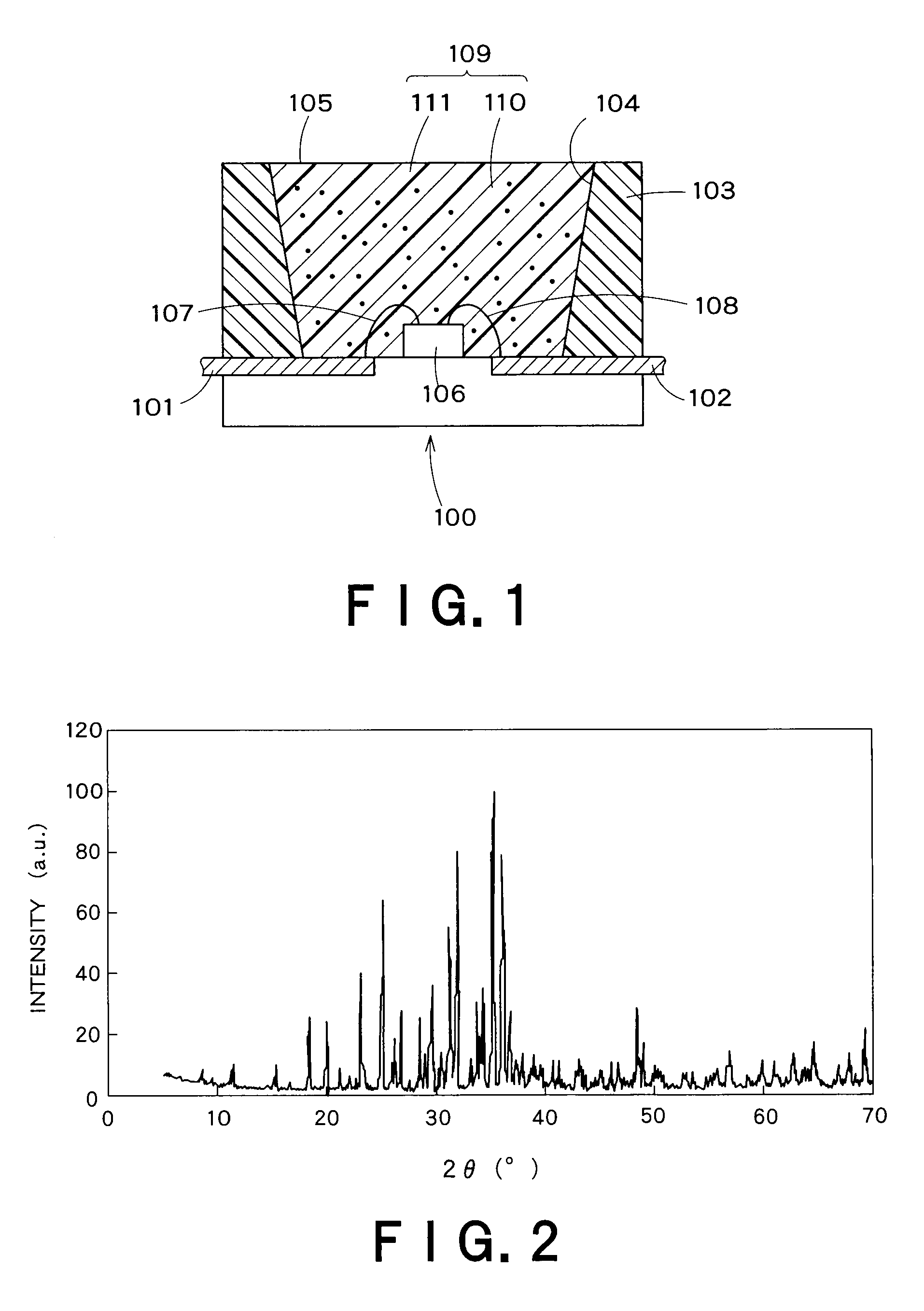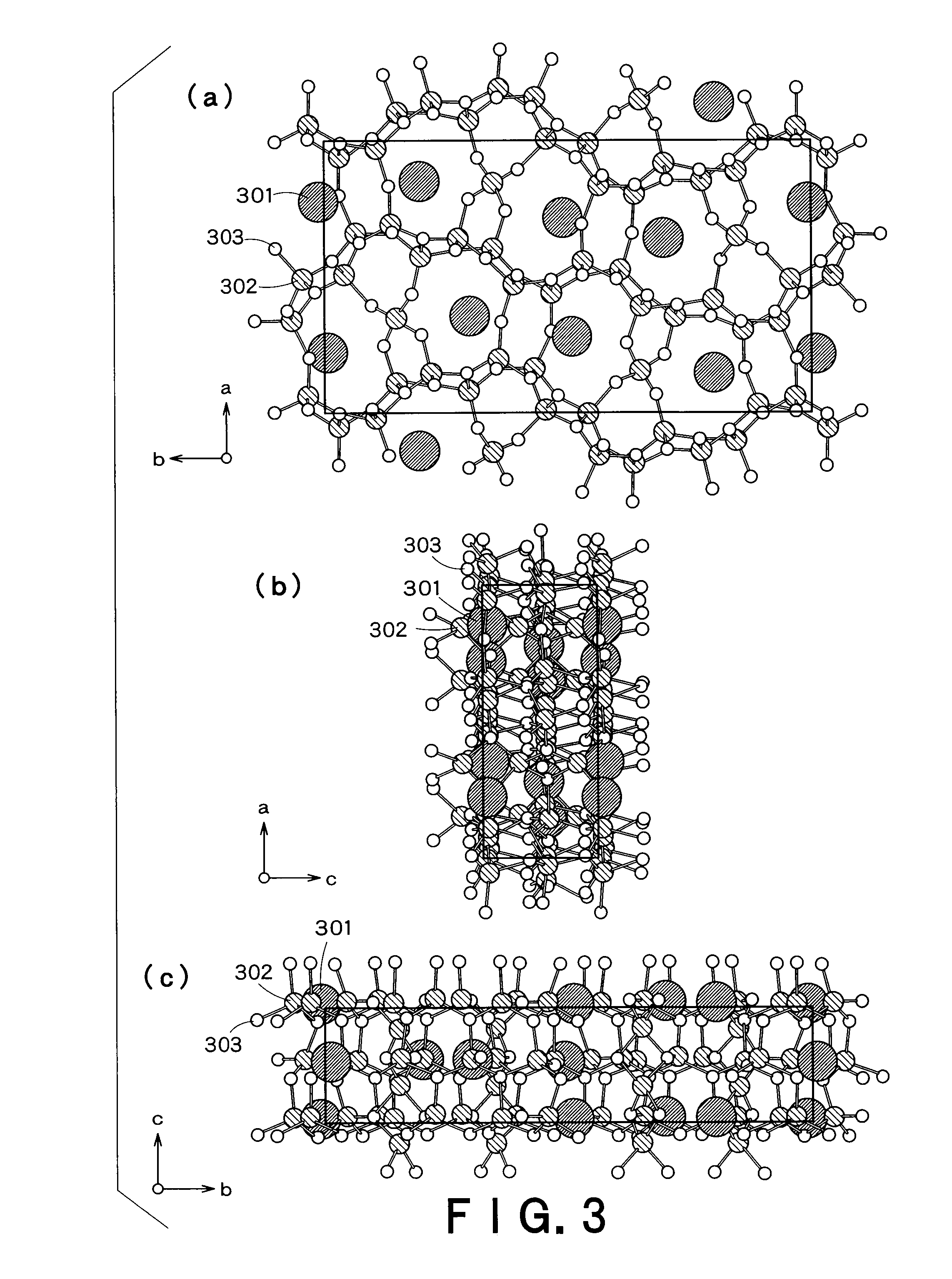Red fluorescent substance and light-emitting device employing the same
a technology of fluorescent substances and light-emitting devices, which is applied in the direction of discharge tubes/lamp details, discharge tubes luminescent screens, discharge tubes/lamp details, etc., can solve the problems of serious “color drift” and loss of light emitted from fluorescent substances, and achieve the effect of further reducing color dri
- Summary
- Abstract
- Description
- Claims
- Application Information
AI Technical Summary
Benefits of technology
Problems solved by technology
Method used
Image
Examples
example 1
[0114]As the starting materials, Sr3N2, EuN, Si3N4, Al2O3 and AlN in the amounts of 2.676 g, 0.398 g, 6.080 g, 0.680 g and 0.683 g, respectively, were weighed and dry-mixed in an agate mortar in a vacuum glove box. The mixture was placed in a BN crucible and then fired at 1850° C. for 4 hours under 7.5 atm of N2 atmosphere, to synthesize a fluorescent substance (G1) whose designed composition was (Sr0.92Eu0.08)3Al3Si13O2N21.
[0115]The fluorescent substance (G1) obtained by firing was in the form of yellowish green powder, and was observed to emit green luminescence when excited by black light.
[0116]Independently, as the starting materials, Sr3N2, EuN, Si3N4, Al2O3 and AlN in the amounts of 2.579 g, 0.232 g, 4.583 g, 0.476 g and 1.339 g, respectively, were weighed and dry-mixed in an agate mortar in a vacuum glove box. The mixture was placed in a BN crucible and then fired at 1850° C. for 4 hours under 7.5 atm of N2 atmosphere, to synthesize a fluorescent substance (R1) whose designed...
example 2
[0120]The procedure of Example 1 was repeated to synthesize the green fluorescent substance (G1). Thereafter, the procedure of Example 1 was further repeated except for changing the amounts of Sr3N2 and EuN into 2.660 g and 0.093 g, respectively, to synthesize a red fluorescent substance (R2) whose designed composition was (Sr0.98Eu0.02)2Al3Si7ON13. The emission spectrum of the obtained red fluorescent substance (R2) under the excitation at 457 nm was shown in FIG. 4, and the result of component analysis (in terms of molar ratio normalized based on the Al content) was summarized in Table 3.
[0121]A light-emitting diode giving an emission peak at 455 nm was soldered on an 8 mm-square AlN package, and was connected to electrodes by way of gold wires. The light-emitting diode was then domed with transparent resin, and the dome was coated with a layer of transparent resin containing 30 wt. % of the red fluorescent substance (R2) giving an emission peak at 577 nm. Further, another layer o...
example 3
[0123]The procedure of Example 1 was repeated to synthesize the green fluorescent substance (G1). Thereafter, the procedure of Example 1 was further repeated except for changing the amounts of Sr3N2 and EuN into 2.443 g and 0.465 g, respectively, to synthesize a red fluorescent substance (R3) whose designed composition was (Sr0.9Eu0.1)2Al3Si7ON13. The emission spectrum of the obtained red fluorescent substance (R3) under the excitation at 457 nm was shown in FIG. 4, and the result of component analysis (in terms of molar ratio normalized based on the Al content) was summarized in Table 3.
[0124]A light-emitting diode giving an emission peak at 455 nm was soldered on an 8 mm-square AlN package, and was connected to electrodes by way of gold wires. The light-emitting diode was then domed with transparent resin, and the dome was coated with a layer of transparent resin containing 30 wt. % of the red fluorescent substance (R3) giving an emission peak at 607 nm. Further, another layer of ...
PUM
 Login to View More
Login to View More Abstract
Description
Claims
Application Information
 Login to View More
Login to View More - R&D
- Intellectual Property
- Life Sciences
- Materials
- Tech Scout
- Unparalleled Data Quality
- Higher Quality Content
- 60% Fewer Hallucinations
Browse by: Latest US Patents, China's latest patents, Technical Efficacy Thesaurus, Application Domain, Technology Topic, Popular Technical Reports.
© 2025 PatSnap. All rights reserved.Legal|Privacy policy|Modern Slavery Act Transparency Statement|Sitemap|About US| Contact US: help@patsnap.com



